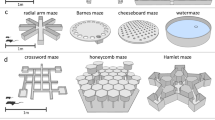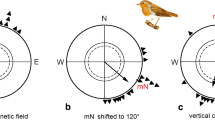Abstract
Path integration is a navigation strategy that requires animals to integrate self-movements during exploration to determine their position in space. The medial entorhinal cortex (MEC) has been suggested to play a pivotal role in this process. Grid cells, head-direction cells, border cells as well as speed cells within the MEC collectively provide a dynamic representation of the animal position in space based on the integration of self-movements. All these cells are strongly modulated by theta oscillations, thus suggesting that theta rhythmicity in the MEC may be essential for integrating and coordinating self-movement information during navigation. In this study, we first show that excitotoxic MEC lesions, but not dorsal hippocampal lesions, impair the ability of rats to estimate linear distances based on self-movement information. Next, we report similar deficits following medial septum inactivation, which strongly impairs theta oscillations in the entorhinal–hippocampal circuits. Taken together, these findings demonstrate a major role of the MEC and MS in estimating distances to be traveled, and point to theta oscillations within the MEC as a neural mechanism responsible for the integration of information generated by linear self-displacements.







Similar content being viewed by others
References
Alyan S, McNaughton BL (1999) Hippocampectomized rats are capable of homing by path integration. Behav Neurosci 113:19–31
Angelaki DE, Dickman JD (2000) Spatiotemporal processing of linear acceleration: primary afferent and central vestibular neuron responses. J Neurophysiol 84:2113–2132
Benhamou S (1997) Path integration by swimming rats. Anim Behav 54:321–327
Blair HT, Welday AC, Zhang K (2007) Scale-invariant memory representations emerge from moiré interference between grid fields that produce theta oscillations: a computational model. J Neurosci 27:3211–3229
Brandon MP, Bogaard AR, Libby CP, Connerney MA, Gupta K, Hasselmo ME (2011) Reduction of theta rhythm dissociates grid cell spatial periodicity from directional tuning. Science 332:595–599. doi:10.1126/science.1201652
Brun VH, Solstad T, Kjelstrup KB, Fyhn M, Witter MP, Moser EI, Moser MB (2008) Progressive increase in grid scale from dorsal to ventral medial entorhinal cortex. Hippocampus 12:1200–1212. doi:10.1002/hipo.20504
Burak Y, Fiete IR (2009) Accurate path integration in continuous attractor network models of grid cells. PLoS Comput Biol 5:e1000291. doi:10.1371/journal.pcbi.1000291
Burgess N, Barry C, O’Keefe J (2007) An oscillatory interference model of grid cell firing. Hippocampus 17:801–812
Buzsáki G (2002) Theta oscillations in the hippocampus. Neuron 33:325–340
Chen X, He Q, Kelly JW, Fiete IR, McNamara TP (2015) Bias in human path integration is predicted by properties of grid cells. Curr Biol 25:1771–1776
Chrobak JJ, Stackman RW, Walsh TJ. 1989. Intraseptal administration of muscimol produces dose-dependent memory impairments in the rat. Behav Neural Biol 52:357–369.
Deshmukh SS, Knierim JJ (2011) Representation of non-spatial and spatial information in the lateral entorhinal cortex. Front Behav Neurosci 5:69. doi:10.3389/fnbeh.2011.00069
Etienne AS, Jeffery KJ (2004) Path integration in mammals. Hippocampus 14:180–192
Etienne AS, Maurer R, Séguinot V (1996) Path integration in mammals and its interaction with visual landmarks. J Exp Biol 199:201–209
Fanselow MS, Dong HW (2010) Are the dorsal and ventral hippocampus functionally distinct structures? Neuron 65:7–19. doi:10.1016/j.neuron.2009.11.031
Fuhs MC, Touretzky DS (2006) A spin glass model of path integration in rat medial entorhinal cortex. J Neurosci 26:4266–4276
Gaussier P, Banquet JP, Sargolini F, Giovannangeli C, Save E, Poucet B (2007) A model of grid cells involving extra hippocampal path integration, and the hippocampal loop. J Integr Neurosci 6:447–476
Giocomo LM, Zilli EA, Fransén E, Hasselmo ME (2007) Temporal frequency of subthreshold oscillations scales with entorhinal grid cell field spacing. Science 315:1719–1722
Hafting T, Fyhn M, Molden S, Moser MB, Moser EI (2005) Microstructure of a spatial map in the entorhinal cortex. Nature 436:801–806. doi:10.1038/nature03721
Hafting T, Fhyn M, Bonnevie T, Moser MB, Moser EI (2008) Hippocampus-independent phase precession in entorhinal grid cells. Nature 453:1248–1252. doi:10.1038/nature06957
Hok V, Chah E, Save E, Poucet B (2013) Prefrontal cortex focally modulates hippocampal place cell firing patterns. J Neurosci 33:3443–3451. doi:10.1523/JNEUROSCI.3427-12.2013
Howard LR, Javadi AH, Yu Y, Mill RD, Morrison LC, Knight R, Loftus MM, Staskute L, Spiers HJ (2014) The hippocampus and entorhinal cortex encode the path and Euclidean distances to goals during navigation. Curr Biol 24:13331–13340. doi:10.1016/j.cub.2014.05.001
Insausti R, Herrero MT, Witter MP (1997) Entorhinal cortex of the rat: cytoarchitectonic subdivisions and the origin and distribution of cortical efferents. Hippocampus 7:146–183. doi:10.1002/(SICI)1098-1063(1997)7:2<146::AID-HIPO4>3.0.CO;2-L
Jacob PY, Poucet B, Liberge M, Save E, Sargolini F (2014) Vestibular control of entorhinal cortex activity. Front Integr Neurosci 8:38. doi:10.3389/fnint.2014.00038
King C, Recce M, O’Keefe J (1998) The rhythmicity of cells of the medial septum/diagonal band of Broca in the awake freely moving rat: relationships with behaviour and hippocampal theta. Eur J Neurosci 10:464–477
Knierim JJ, Neunuebel JP, Deshmukh SS. 2014. Functional correlates of lateral and medial entorhinal cortex: objects, path integration and local-global reference frames. Phil Trans Roy Soc B 369:20130369. doi:10.1098/rstb.2013.0369
Koenig J, Linder AN, Leutgeb JK, Leutgeb S (2011) The spatial periodicity of grid cells is not sustained during reduced theta oscillations. Science 332:592–595. doi:10.1126/science.1201685
Kramis R, Vanderwolf CH, Bland BH (1975) Two types of hippocampal rhythmical slow activity in both the rabbit and the rat: relations to behavior and effects of atropine, diethyl ether, urethane, and pentobarbital. Exp Neurol 49:58–85
Kraus BJ, Brandon MP, Robinson RJ, Connerney MA, Hasselmo ME, Eichenbaum H (2015) During running in place, grid cells integrate elapsed time and distance run. Neuron 88:578–589. doi:10.1016/j.neuron.2015.09.031
Kropff E, Carmichael JE, Moser MB, Moser EI (2015) Speed cells in the medial entorhinal cortex. Nature 523:419–424. doi:10.1038/nature14622
Langston RF, Wood ER (2010) Associative recognition and the hippocampus: differential effects of hippocampal lesions on object-place, object-context and object-place-context memory. Hippocampus 20:1139–1153. doi:10.1002/hipo.20714
Lecourtier L, de Vasconcelos AP, Leroux E, Cosquer B, Geiger K, Lithfous S, Cassel JC (2011) Septohippocampal pathways contribute to system consolidation of a spatial memory: sequential implication of GABAergic and cholinergic neurons. Hippocampus 21:1277–1289. doi:10.1002/hipo.20837
Ma J, Shen B, Stewart LS, Herrick IA, Leung LS (2002) The septohippocampal system participates in general anesthesia. J Neurosci 22:RC200
Maaswinkel H, Jarrad LE, Whishaw IQ (1999) Hippocampectomized rats are impaired in homing by path integration. Hippocampus 9:553–561
Martin MM, Horn KL, Kusman KJ, Wallace DG (2007) Medial septum lesions disrupt exploratory trip organization: evidence for septohippocampal involvement in dead reckoning. Physiol Behav 90:412–424
McDonald JH (2014) Handbook of biological statistics. Sparky House Publishing, Baltimore
McNaughton BL, Battaglia FP, Jensen O, Moser EI, Moser MB (2006) Path integration and the neural basis of the ‘cognitive map’. Nat Rev Neurosci 7:663–678
Mitchell SJ, Rawlins JNP, Steward O, Olton DS (1982) Medial septal area lesions disrupt theta rhythm and cholinergic staining in medial entorhinal cortex and produce impaired radial arm maze behavior in rats. J Neurosci 2:292–302
Mittlestaedt H, Mittlestaedt ML (1982) Homing by path integration. In: Papi F, Wallraff HG (eds). Avian navigation. Springer, Berlin, pp 290–297
Mizumori SJY, Perez GM, Alvarado MC, Barnes CA, McNaughton BL (1990) Reversible inactivation of the medial septumdifferentially affect two forms of learning in rats. Brain Res 528:12–20
Moser EI, Moser MB (2008) A metric for space. Hippocampus 18:1142–1156. doi:10.1002/hipo.20483
Navratilova Z, Giocomo LM, Fellous JM, Hasselmo ME, McNaughton BL (2012) Phase precession and variable spatial scaling in a periodic attractor map model of medial entorhinal grid cells with realistic after-spike dynamics. Hippocampus 22:772–789. doi:10.1002/hipo.20939
Parron C, Save E (2004) Evidence for entorhinal and parietal cortices involvement in path integration in the rat. Exp Brain Res 159:349–359
Paxinos G, Watson C. 2004. The rat brain in stereotaxic coordinates. Academic Press, New York
Rawlins JNP, Feldon J, Gray JA (1979) Septohippocampal connections and the hippocampal theta rhythm. Exp Brain Res 37:49–63
Sargolini F, Fyhn M, Hafting T, McNaughton BL, Witter MP, Moser MB, Moser EI (2006) Conjunctive representation of position, direction, and velocity in entorhinal cortex. Science 312:758–762
Save E, Guazzelli A, Poucet B (2001) Dissociation of the effects of bilateral lesions of the dorsal hippocampus and parietal cortex on path integration in the rat. Behav Neurosci 115:1212–1223
Savelli F, Yoganarasimha D, Knierim JJ (2008) Influence of boundary removal on the spatial representations of the medial entorhinal cortex. Hippocampus 18:1270–1282. doi:10.1002/hipo.20511
Solstad T, Boccara CN, Kropff E, Moser MB, Moser EI (2008) Representation of geometric borders in the entorhinal cortex. Science 322:1865–1868. doi:10.1126/science.1166466
Steffenach HA, Witter M, Moser MB, Moser EI (2005) Spatial memory in the rat requires the dorsolateral band of the entorhinal cortex. Neuron 45:301–313
Tsao A, Moser MB, Moser EI (2013) Traces of experience in the lateral entorhinal cortex. Curr Biol 23:399–405
Van Cauter T, Camon J, Alvernhe A, Elduayen C, Sargolini F, Save E (2013) Distinct roles of medial and lateral entorhinal cortex in spatial cognition. Cereb Cortex 23:451–459. doi:10.1093/cercor/bhs033
Wallace DG, Whishaw IQ (2003) NMDA lesions of Ammon’s horn and the dentate gyrus disrupt the direct and temporally paced homing displayed by rats exploring a novel environment: evidence for a role of the hippocampus in dead reckoning. Eur J Neurosci 18:513–523
Whishaw IQ, Tomie JA (1997) Piloting and dead reckoning dissociated by fimbria—fornix lesions in a rat food carrying task. Behav Brain Res 89:87–97
Whishaw IQ, Hines DJ, Wallace DG (2001) Dead reckoning (path integration) requires the hippocampal formation: evidence from spontaneous exploration and spatial learning in light (allothetic) and dark (idiothetic) tests. Behav Brain Res 127:49–69
Winter SS, Köppen JR, Ebert TB, Wallace DG (2013) Limbic system structures differentially contribute to exploratory trip organization of the rat. Hippocampus 23:139–152. doi:10.1002/hipo.22075
Winter SS, Mehlman ML, Clark BJ, Taube JS (2015) Passive transport disrupts grid signals in the parahippocampal cortex. Curr Biol 25:2493–2502. doi:10.1016/j.cub.2015.08.034
Acknowledgements
We thank Boris Burle for help with data analysis, and the Spatial Cognition group for discussion. Financial support was provided by the Institut Universitaire de France to FS. P.Y.J. salary was financed by the Fondation pour la Recherche Médicale (Paris).
Author information
Authors and Affiliations
Corresponding author
Ethics declarations
Conflict of interest
The authors declare no competing financial interests.
Additional information
E. Save and F. Sargolini contributed equally to the study.
Electronic supplementary material
Below is the link to the electronic supplementary material.
Rights and permissions
About this article
Cite this article
Jacob, PY., Gordillo-Salas, M., Facchini, J. et al. Medial entorhinal cortex and medial septum contribute to self-motion-based linear distance estimation. Brain Struct Funct 222, 2727–2742 (2017). https://doi.org/10.1007/s00429-017-1368-4
Received:
Accepted:
Published:
Issue Date:
DOI: https://doi.org/10.1007/s00429-017-1368-4




